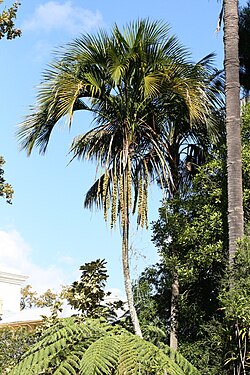| Howea belmoreana | |
|---|---|
 | |
| Howea belmoreana | |
| Scientific classification | |
| Kingdom: | Plantae |
| Clade: | Tracheophytes |
| Clade: | Angiosperms |
| Clade: | Monocots |
| Clade: | Commelinids |
| Order: | Arecales |
| Family: | Arecaceae |
| Genus: | Howea |
| Species: | H. belmoreana |
| Binomial name | |
| Howea belmoreana (C. Moore & F.Muell.) Becc. | |
 | |
| H. belmoreana is endemic to Lord Howe Island | |
Howea belmoreana, the curly palm, kentia palm, or Belmore sentry palm, is a species of flowering plant in the family Arecaceae, endemic to Lord Howe Island, Australia. It and Howea forsteriana probably evolved from a common ancestor through sympatric speciation. [2] The canopy of a mature kentia palm tree spreads 5–10 ft (2–3 m) in diameter and contains roughly 36 leaves. [3]
Howea belmoreana has gained the Royal Horticultural Society's Award of Garden Merit. [4] [5]
